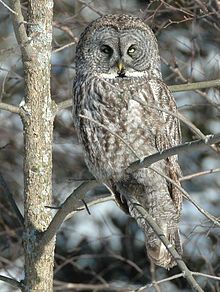Strix (genus)
|
Strix owls Temporal range: Early Miocene to recent |
|
|---|---|
 |
|
| Great grey owl, Strix nebulosa | |
| Scientific classification | |
| Kingdom: | Animalia |
| Phylum: | Chordata |
| Class: | Aves |
| Order: | Strigiformes |
| Family: | Strigidae |
| Genus: |
Strix Linnaeus, 1758 |
| Species | |
|
Some 15, see text. |
|
| Synonyms | |
|
Ptynx Blyth, 1840 |
|
Some 15, see text.
Ptynx Blyth, 1840
Stryx Pallas, 1771 (unjustified emendation)
Strix is a genus of owls. They belong to the typical owl family (Strigidae), one of the two generally accepted living families of owls, with the other being the barn-owls (Tytonidae). Common names are earless owls or wood owls though they are not the only owls without ear tufts, and "wood owl" is also used as a more generic name for forest-living owls. Neotropical birds in the genus Ciccaba are sometimes included in Strix.
These are medium-sized to largish, robustly-built and powerful owls. They do not have ear tufts and most are highly nocturnal woodland birds. Most live on small mammals, birds and reptiles.
Most owls in the Strix Genus vocalise through hooting and lack visible ears - this is how they are distinguished from other genera of owls.
The Latin genus name Strix referred to a type of owl believed to suck the blood of infants. Although the genus Strix was established for the earless owls by Linnaeus in 1758, until the late 19th century many authors applied it to other owls – namely the Tyto barn-owls – in error.
The genus Strix is well represented in the fossil record. Being a fairly generic type of strigid owl, they were probably the first truly modern Strigidae to evolve. However, it is not certain whether several of the species usually placed in this genus indeed belong here.
Generally accepted in Strix are:
"Strix" wintershofensis (Early/Middle Miocene of Wintershof West, Germany) and "Strix" edwardsi (Middle Miocene of Grive-Saint-Alban, France), while being strigid owls, have not at present been reliably identified to genus; they might also belong into the European Ninox-like group.
...
Wikipedia
